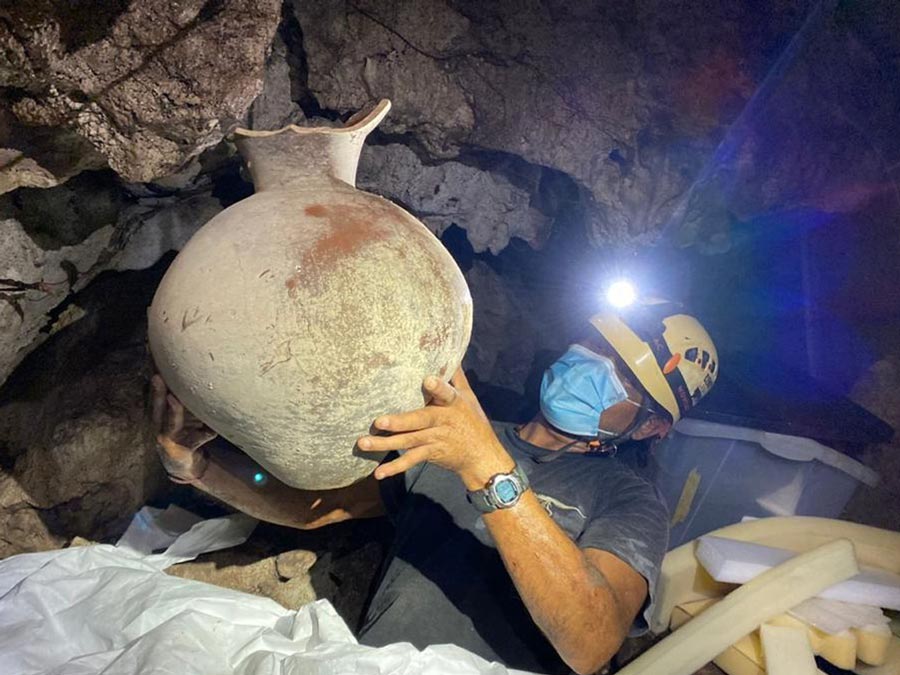A recent pottery find dating to the Late Postclassic Maya period by archaeologists from the National Institute of Anthropology and History (INAH) in Chemuyil town of Mexico’s Quintana Roo state shows that caves were sites for Maya rituals in the pre-Hispanic period. The highly structured Maya universe was divided into 13 levels of heaven, the Earth, and 9 watery underworld levels. Caves were important sites for Maya rituals for the Maya people, who believed they served as portals to Xibalba, the underworld presided over by the Maya death gods and their helpers, according to a press release by INAH.

Caves were also where the Maya obtained clean drinking water from stalactites and cenotes. Cenotes, which are common in the Yucatán Peninsula of Mexico, are natural wells or reservoirs formed by the collapse of limestone bedrock exposed to groundwater.
The Maya civilization was a Mesoamerican civilization that flourished between 2000 BC and 1697 AD, in the area that is now Mexico, Guatemala and Belize, as well as the western parts of the Honduras and El Salvador. The Spanish conquered the last independent Maya kingdom in 1697.

This globular pot, used in Maya rituals in the pre-Hispanic era, was found fragmented because the roots of a tree that had grown into the cave had crushed it against some rocks.
Maya Rituals: Offerings of Cave Water in Large VesselsThe team of archaeologists under the direction of Antonio Reyes, head of its Cultural Property Protection wing, found two vessels, one almost whole and the other broken, and a tripod bowl dating to the Late Postclassic period (1200-1550 AD). They were discovered in an inner, remote part of the Quintana Roo caves.
The first of the two vessels was a Navulá-type monochrome vessel with a typical concave cavity that is complete but for one of its two handles. Navulá unslipped ware is a basic type of pottery common to the Postclassic Maya period. The other vessel, of similar production, was a globular pot that was found fragmented because the roots of a tree that had grown into the cave had crushed it against some rocks. The two were placed in natural niches in the cave to collect water dripping from stalactites.

The tripod bowl is more finely made and has conical supports. It was placed face down, again near a water body that is believed to flow in the lower part of the cave. “The bowl was placed face down and covered with stones, so it is clear that it is an offering, while the vessels were used for the ritual collection of the pristine water that came down from the stalactites,” the INAH press release stated.
Although no major Maya sites have been discovered in Chemuyil, people living in the region between Playa del Carmen and Tulum often used the cenotes and caverns located there for ritual purposes.

The conical support Maya tripod bowl, used in pre-Hispanic Maya rituals, found in the cave was more finely made and was placed face down near a water body.
A Wise Civil Society Initiative to Preserve and ConserveWhat is remarkable is that it was a civil society initiative that alerted the INAH to the presence of the artifacts. Members of the Círculo Espeleológico del Mayab and the Urban Cenotes Project of Playa del Carmen, dedicated to the registration and mapping of the caves in this region, apprised the INAH Quintana Roo Center that archaeological fragments inside a natural cavity in the vicinity of the town of Chemuyil were under threat owing to public access to the site. Archaeologist Antonio Reyes was deputed by the INAH to carry out the rescue operation. The INAH stated:
“The remarkable thing about the finding is that it derives from a citizen complaint. The Urban Cenotes Project of Playa del Carmen , led by biologist Roberto Rojo, has been collaborating with the INAH Quintana Roo Center for just over four years, carrying out explorations and mapping of caves and cenotes located in the urban area of Playa del Carmen and its surroundings; and when paleontological and / or archaeological elements are located inside these formations, they are reported to the INAH Quintana Roo Center for their intervention.”

Meanwhile the artifacts have been carefully packed off to the Mayan Museum in Cancun. There they are being subjected to cleaning , after which they will undergo restoration. Finally, together with the information about where they were found, they will be registered in the INAH records.
It is to be hoped that the successful collaboration between government and civil society bodies in Mexico will continue and serve to rescue and preserve more of the nation’s rich cultural heritage.





